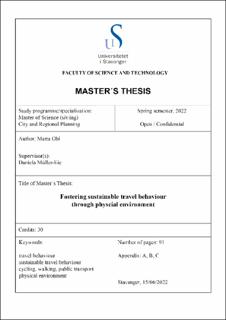| dc.description.abstract | Growing public awareness about the negative impacts of cities dependent on cars as a major means of mobility on ecological issues, public health and monetary cost have pushed government policies for the search of urban mobility alternatives based on the promotion of active transportation mode like walking, cycling and public transport all around the world.
Universities are large employers, thus are an important generator of travel demand on the transportation network. On the other hand, it puts them in a good position to advocate and help foster an active and sustainable lifestyle.
This thesis aims to find out how sustainable travel behaviour among University of Stavanger students can be fostered through the physical environment. The thesis approach was through a case study of University of Stavanger (UiS) with Campus Ullandhaug in Norway and Linköping University (LiU) with Campus Valla in Sweden that have similar characteristics to UiS but very different travel behaviour.
Different literature were retrieved and reviewed to form the bases for this thesis, the reviews form the foundation and dictate the direction that this thesis followed. It highlighted the variables that were examined in the data collection and questions that were asked in the survey chapter. These variables that influence sustainable transport choice were found to be either objective or subjective factors or variables.
For the Objective variables, spatial analysis was carried out on two different universities (LiU and UiS) with similar land mass and student population but very different travel behaviour.
Furthermore, a survey was carried out on both universities. Questionnaires were formulated to capture the subjective variable and were distributed online and in person at both universities. The survey aimed at investigating students’ attitude towards the three sustainable travel choices.
The spatial analysis shows more hilly terrain in UiS while LiU is a more or less flat surface. Less connectivity in UiS (especially for cycling) with few roads leading to dead-end while LiU is well connected especially for cycling.
Most student dormitories are situated within 2km cycling distance in LiU while UiS sees most of its dormitories located outside this range.
The research from this study is in line with a lot of other findings on the relationship between sustainable transport mode (cycling, walking and public Transport) and characteristics of the built environment.
Land use mix and quality of the transport infrastructure determines how, where and what modal choice students use when commuting.
Reducing cycling distance to within 2km for example, locating student dormitories within 2km cycling distance and 500m walking distance to campuses was found to motivate cycling and walking. Connections to transit or bus stations and combining different sustainable transport modes, (for example cycling and public bus, or walking and public bus) on those student dormitories more than 2km distance can encourage sustainable transport behaviour. | |
